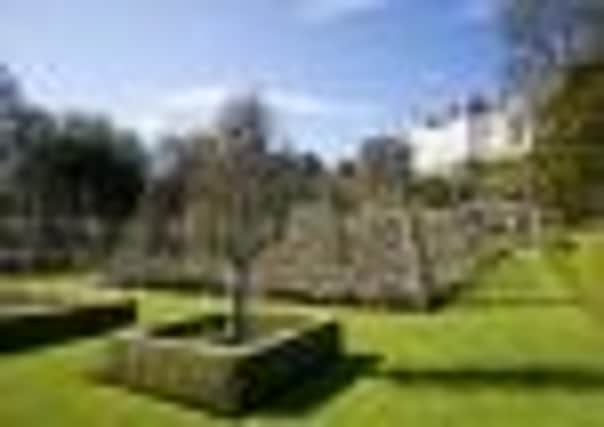Parterre people


A line of weeping, silver leafed Pyrus salicifolia, white-berried Sorbus cashmiriana and Fraxinus ornus – the latter, Iain worries, could be vulnerable to ash dieback – were underplanted in November with a palette of white daffodils, including the bold trumpets of “Ice Follies”, late-scented jonquilla “Pueblo” and the exciting new hybrid bulbocodium “Spoirot”.
The ancestral home of the Earls and Dukes of Sutherland, and currently owned by the Countess of Sutherland whose son, Lord Strathnaver, oversees the garden, Dunrobin perches in a vertiginous position on the edge of a cliff overlooking the Moray Firth. There is a view of the Cairngorms in the distance. In 1850 Sir Charles Barry, the architect who built the Houses of Parliament, designed the fairy-tale castle, complete with towers and turrets and laid out the garden at the foot of the cliff.
Advertisement
Hide AdAdvertisement
Hide AdDrawing inspiration from the classical layout at the Palais de Versailles, Barry created a spectacular Italianate design of formal, box-edged parterres centred on gravity-fed ponds. In the Pyramid Garden, wide grass allées divide beds punctuated by clipped hornbeam pyramids that give way to wooden pyramids topped with balls. A reminder that this is a Highland garden comes in the largest parterre. This is said to represent a highlander’s targe, or leather shield, with the central fountain and surrounding clipped yews representing spike and studs. The hedged beds illustrate stitched panels.
Remaining largely unchanged, this classical layout provides a framework for a succession of plants that recall relatively sustainable Edwardian colour schemes. Tulips, underplanted with Forget-me-knots and scented wallflowers, are followed by bold perennial planting and massed dahlias that last well into the autumn.
The scene is set by the end of February when the first daffodils, the charming Narcissus Cyclamineus “February Gold”, burst into flower on the south-facing slopes below the castle. Iain explains: “Most years they are well out by Mothering Sunday, my children are the only ones who get to pick them.” Iain who came to Dunrobin 12 years ago with his wife Clare, has eight children; his oldest son is also a gardener who trained with the RBGE.
Iain explains why gardening to this standard is possible in a plot situated just a few degrees north of Moscow. “The castle benefits from the last kiss of the Gulf Stream after it runs through the Pentland Firth south of Orkney,” he says, adding that challenges include late frosts and the salt-laden winds that sweep in from the sea.
Flowering just in time for the castle opening in April are the thousands and thousands of “Golden Harvest” daffodils beneath the lime trees on both sides of the main drive. For visitors arriving by train, Iain continues, there is beauty in the beds of mixed single and double daffodils combined with hardy fuchsias surrounded by low paling fences at both ends of the railway station platform.
These established hybrids, Iain says, flower reliably despite their exposed position close to the sea; tall varieties are used for flower arranging in the castle. “After flowering the fuchsia are cut back to 18in and their wooded stems help support the daffodils. The new fuchsia growth hides the yellowing daffodil leaves.”
When planting bulbs in large numbers time is saved by punching holes into the ground with a fat-pointed pinchbar. The bulb is then dropped into the hole, where it “hopefully lands the right way up. Nothing eats daffodil bulbs; we don’t even bother to fill the holes or cover the bulbs. The holes usually fill in naturally over a couple of years.”
Equally charming are the glorious drifts of scented Pheasant’s Eye narcissus allowed to naturalise in the woodlands, once the site of extensive nursery beds. “These follow on from snowdrops and are succeeded by bluebells.”
Advertisement
Hide AdAdvertisement
Hide AdPlans for the future include the restoration of a lost Victorian rill. Left to dry for more than 40 years when it filled with leaves and weeds, this winding woodland burn is being rediscovered. “Over the next two or three seasons we hope to get the water flowing again, planting ferns, candelabra primulas, sweet cicely and skunk cabbage,” Iain says.
But, there is one kind of daffodil, frequently used in the castle flower arrangements, that you won’t find in the garden. This is the pink-tinged Mrs RO Backhouse or its cousin, the densely crowded double flowered “White Marvel”. Hidden away in a remote part of the garden these are “smuggled out at dusk and put in buckets in the flower room to condition”. The sight of a pink daffodil, Iain suggests, can jar in a naturalistic scheme, but when part of a flower arrangement in an Edwardian drawing room, they shine.
In his website introduction to Dunrobin Castle Lord Strathnaver refers to his ancestral home as “The Jewel in the Crown of the Highlands”. It’s a bold claim and one easy to dismiss as an enthusiastic comment of an owner keen to attract visitors, but in the case of the garden at Dunrobin it sits pretty close to the mark. And if you miss the daffodils you might just be in time for the bluebells, or even the tulips.
Dunrobin Castle and Gardens, Golspie KW10 6SF. Open April, May, Sept and Oct, Mon–Sat 10:30am–4:30pm, Sun noon–4:30pm; June, July, August, Mon–Sun 10am–5pm; tel: 01408 633177 or visit www.dunrobincastle.co.uk